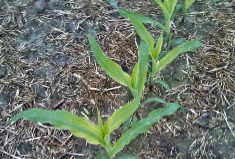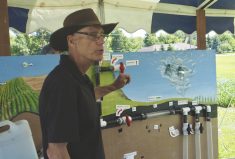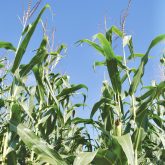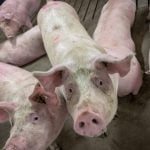What’s vertical tillage? It seems like a simple three-word question, and you’d expect the answer to be just as straightforward. But no matter which farmer, equipment dealer or agronomist you ask, or how many times you ask them, you’re likely to get a different answer every time.
In no small part that’s because the focus of vertical tillage has evolved over time, affected by everything from advances in corn genetics to the widespread adoption of zero tillage.
Read Also

Could crop sharing be a viable option for your farm?
Crop sharing could be a good option for young and beginning farmers.
Historically, the first vertical-tillage systems were introduced by manufacturers including Aerway, Phoenix, Phillips, McFarlane, Summers, Great Plains and Salford. They could slice the ground and create — as some in the U.S. have referred to it — “tillage for no tillers.”
Then came the late 1990s and early 2000s, when vertical tillage began to be known as “deep ripping.” That practice came to the fore as a remedy for compacted plow pans, with a bid to disturb the soil surface as little as possible. In fact, when watching deep-ripping demonstrations at trade shows such as Canada’s Outdoor Farm Show, it was surprising to see just how much of the surface remained relatively intact, including any residues.
Although he acknowledges that definitions and practices have changed in the past 10 to 15 years, Leo Guilbeault has always used vertical tillage to manage his residues. Farming about 2,000 acres near Belle River in Essex County, Guilbeault has been no tilling for 25 years, and part of that evolution goes back to the day when no till was exactly that, you left all of the residue on the ground after the harvest.
“The problem with that is that after a few years, you got too much residue, and it wasn’t breaking down,” says Guilbeault, who’s been using a Salford RTS unit for 10 years. “With these new corn hybrids and soybean varieties that are giving us more consistently high yields, you get a 200-bushel corn crop or even a 50-bushel soybean crop, it leaves a lot of residue and it’s just not breaking down quick enough. So the spring stays too cold and wet because there’s too much residue covering the ground.”
Using the system he has in place, Guilbeault says his soil organic matter content has increased substantially, and he’s done the comparisons with soil tests from 20 years ago versus those done this year. But he also notes that the stronger stalks that have become testaments to the work of plant breeders and the seed companies have become something of a bane to farmers. He adds that he’s helped strengthen the stalks as well, adding boron and sulphur to his fertilizer mixes and keeping the plant healthier.
“But with the RTS, it does a good job — two quick shots of that and it mixes enough soil with the residue to help with the breakdown process,” says Guilbeault.
In the past couple of years, soil health and residue management have taken more of a centre-stage position in vertical tillage discussions. This has happened for a number of reasons. Most importantly, research evidence has begun to mount that suggests much of the deep ripping wasn’t being done properly. In many cases, the shanks and shovels were simply lifting the soil profile and dropping it back in place, causing reconsolidation without providing a solution.
One former equipment dealer pointed out that if a farmer didn’t diagnose the problem by digging a soil pit and properly identifying the existence and location of a plow pan layer, he was more likely to fail in his bid to remediate compaction. Without a soil pit, the depth was more of a guess, and in one case that this dealer witnessed, the farmer’s tractor wasn’t powerful enough to pull the implement at the required depth, and he wound up burying and damaging the rear wheels.
- From the Grainews website: Minimizing soil compactions
The other factor that’s played into vertical till’s recent evolution is increased corn yields. The genetics have improved substantially in the past 10 years, and advances in agronomy and the use of seed treatments have enabled growers to plant earlier with longer-season hybrids. That’s left farmers to deal with tougher, somewhat greener stover, and that’s driven the equipment manufacturers, agronomists and researchers to make necessary adjustments to what defines vertical tillage.
Steve Hosking, a product specialist with equipment-maker Sunflower Manu-facturing, suggests we’ve now reached a new generation of vertical tillage.
Hosking believes the first phase ran its course because it did a good job of opening up the surface and letting air and moisture in to infiltrate the soil, but didn’t do a good job of managing crop residue. It left it unanchored on the surface of the field, and there was the risk that the tillage operation would cut it into pieces small enough to be carried off the field by wind and water.
“This is where the second generation came in, that not only did we have to cut up the residue, we also had to anchor the residue so that it wouldn’t move,” says Hosking. “What they were trying to do in the first place was start the decomposition process a little faster, trying to handle those increased yields that we were getting and of course, the Bt stalks that were so much tougher to cut in the first place. By anchoring the stalks, it accelerated that decomposition process, so I think where VT is now is that it’s known for residue management.”
But it wasn’t just residue management that needed to improve — some of the early designs had issues with how they moved soil around in the soil profile, creating unintended consequences.
“The other thing we worried about with deep ripping was letting that nice fine soil drop down into those trenches,” says Hosking. “Your nice ground at the top was going beyond where you’d be able to utilize it, and you were basically turning your fields upside down.”
In the early days many fields also had a history of lots of tillage — at times bordering on recreational — which in turn created hard, compacted pans that needed to be broken up, but required some heavy-duty equipment to do the job right.
“The other thing that came into play there was the horsepower required to do (deep ripping). And if you don’t have tiled ground, some guys believe that it was a great way to get rid of compaction. But if they managed their practices differently, as far as not getting on the ground (too early or too wet) to create that compaction in those conditions, or changing tires or reducing truck traffic or restricting them to certain areas, they’d only have to rip those areas that were compacted,” said Hosking.
- From the Grainews website: What to look for in a deep ripper
Today, adds Hosking, growers have to be a lot more creative to overcome the residues they’re helping to create. If growers are rotating their crops, he says, it’s difficult to plant soybeans into the cornstalks left behind by improved genetics but also the longer growing season.
“We can talk about stalk chopper, and that really was the first thing that a lot of guys tried to work with, but that created such a mat, it wasn’t any better to plant into,” says Hosking. There are some growers who will use the stalk chopper as a first step, and then mix it in using vertical tillage. “But if you’re just going to leave that all on top, that’s not the answer.”
The genetics are a large part of the need for change, but the quicker pace and the sense of urgency in the field is also having an impact. According to Roger Murdock, in charge of North American distribution for Ingersoll Tillage Group, farming larger tracts of land often presses farmers to “get the job done” faster. And that means dealing with higher speeds.
“What’s needed in that case is a more aggressive disc blade to process the residue, but you also need a disc blade that will hold its edge,” says Murdock, who is based in Indianapolis, Indiana. “Anybody can come up with a new blade, and after the first 50 to 100 acres, everything looks fine, but it’s when you’re into the thousands of acres that you need to keep that edge to handle that residue that it really matters.”
Murdock makes that distinction in light of the trend he’s seen develop in engineering designs for optimum speeds. Not long ago, that meant a range of four to eight m.p.h. But today, those same disc blades need to withstand speeds of eight to 12 m.p.h., with some influence on speed coming from smaller, more compact farming operations in Europe.
“It’s not only the residue. If you hit a rock at four m.p.h. or you hit a rock at 12 m.p.h., there’s quite a difference,” says Murdock. “There’s a lot that has to be done in metal technology to be able to keep it from shattering or cracking, plus there’s friction that’s involved, as well. Each one of our products that we have is unique to each one of our original equipment, and it’s not just to give them product differentiation, it’s also to give them the optimum performance. Whether we change the concavity, it’s still very specific to that individual’s specific machine.”
Part of what Jim Boak finds both interesting and challenging is the interchangeable nature of the terminology used in describing various forms of tillage. Vertical tillage came to mean deep ripping, which then became synonymous with the Turbo Till (so some other brand-name unit) and now it has become associated with implementation of surface residues.
“My first comment is that vertical tillage is — plain and simple — the vertical movement in the soil,” says Boak, national sales manager at Salford Farm Machinery, near Ingersoll, Ont. “Anything else is conventional tillage, but what’s happening is our language skills don’t lend themselves to getting it right. It’s similar in that we have made a distinction between no till and conventional till, where one is right and one is wrong.”
Boak believes the same thing is happening with vertical tillage and conventional tillage, where one is considered right and the other is wrong. In his opinion, it’s not about which one is correct, it’s about soil and residue management, and it’s about understanding what your farm needs and what matches your philosophy and soil, and then choosing the right tool. These are just tools, he stresses. A researcher in Kansas may be working on the best approach for soils in that state — or an agronomist might be working on solutions for an Essex County grower — but the farm outside of Guelph may need a configuration or combination of treatments that’s completely different.
“One of the things I’m seeing happening, with the tools or this group of tools, is that they all get labelled as vertical tillage,” says Boak, adding that farmers will run their tools too shallow, whether the stalks have been chopped or not — two or three inches deep. “And they get this wonderful black look on top, yet when you dig down, that soil is full of residue.”
Soil, says Boak, digests plant matter in much the same manner as a human stomach digests food. Feed it right and it functions according to expectations. Feed soils poorly and there’s a greater risk of doing more harm than good. If you’re not considering the impacts of air and water passage through the soil profile, or expecting the top two to three inches of soil to do the work of six, you’re going to be disappointed, not only planting into poorly decomposed residues below the surface, but also with the yields and the resulting soil conditions.
“This is the other thing that separates vertical tillage from shallow non-vertical tillage. In true vertical residue management, you are digesting most of those residues on the surface,” warns Boak. “If you are simply mixing residues in the top two inches, you’re just putting those residues into the seed bed.”
This article first appeared in the 2014 Corn Guide
















